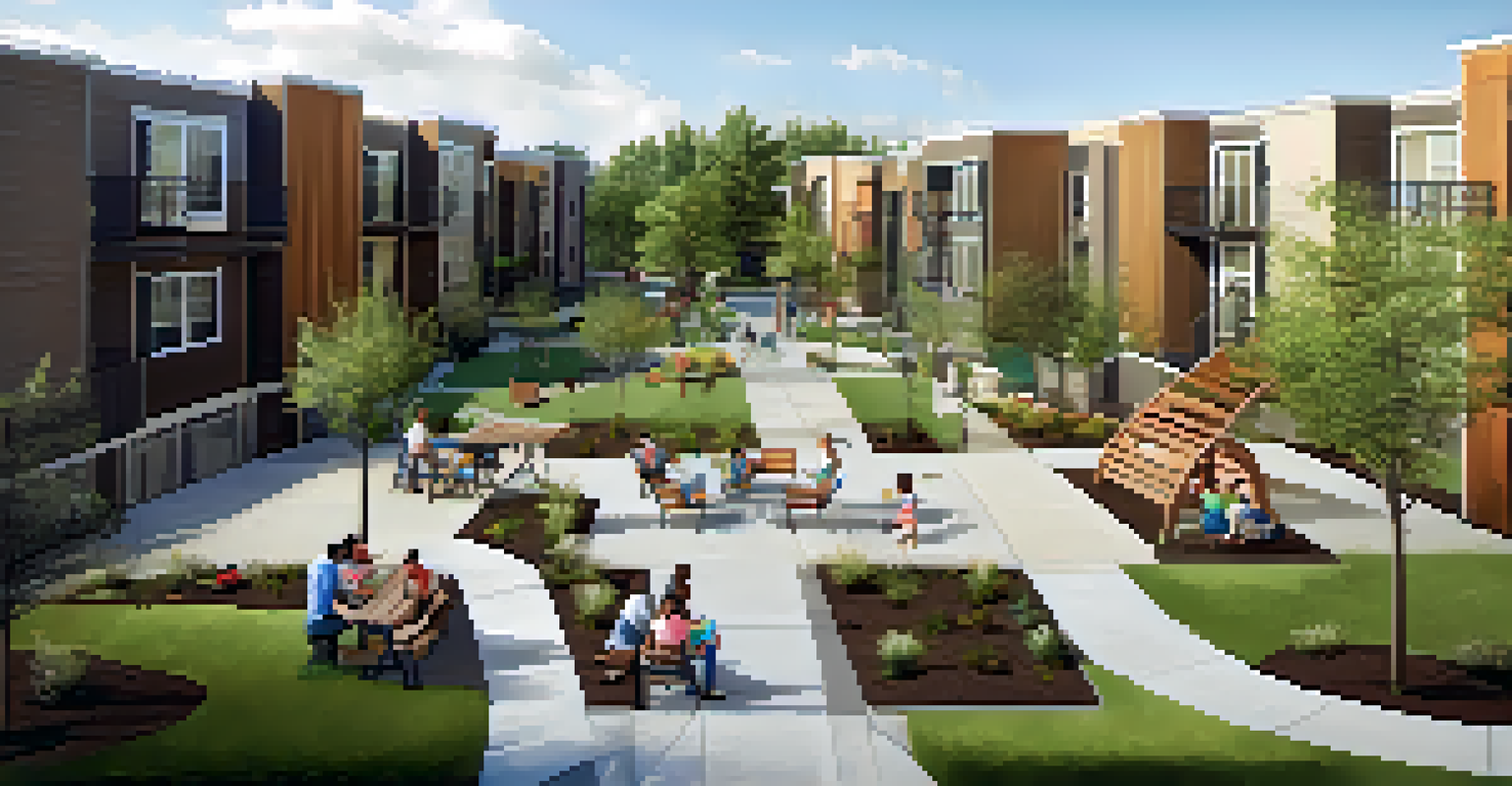The Future of Multi-Family Housing in San Francisco

Rising Demand for Multi-Family Housing in San Francisco
San Francisco has seen a surge in demand for multi-family housing in recent years. This trend stems from various factors, including the city's booming tech industry, which attracts a young, diverse workforce. As more people flock to the city for job opportunities, the need for affordable and accessible housing options becomes increasingly critical.
Housing is a basic need, and everyone deserves a place to call home.
With housing prices skyrocketing, many residents are opting for multi-family units as a cost-effective solution. These homes not only offer a sense of community but also foster a lifestyle that is appealing to those who value shared spaces and amenities. This shift is not just about affordability; it's also about embracing a modern way of living.
As we move forward, urban planners and developers are increasingly focused on creating multi-family housing that meets the needs of a growing population. This includes incorporating sustainable practices, innovative designs, and community-oriented spaces, ensuring that these developments are not just places to live, but vibrant neighborhoods.
Sustainability in Multi-Family Housing Development
Sustainability is no longer just a buzzword; it's a necessity in multi-family housing development. Developers are now prioritizing eco-friendly materials, energy-efficient systems, and green spaces to meet both regulatory requirements and consumer demand. This shift not only benefits the environment but also enhances the quality of life for residents.

For instance, many new multi-family projects in San Francisco are incorporating features like solar panels, rainwater harvesting systems, and electric vehicle charging stations. These initiatives not only reduce the carbon footprint but also lower utility costs for residents, making them even more attractive. It's a win-win situation that aligns economic viability with environmental responsibility.
Growing Need for Affordable Housing
San Francisco's booming population drives demand for multi-family housing as residents seek more affordable and community-focused living options.
Moreover, as the public becomes more conscious of climate change, the demand for sustainable living options is likely to grow. Developers who embrace this trend will not only meet market expectations but also contribute to a healthier, greener city, setting a standard for future housing projects.
The Role of Technology in Housing Innovations
Technology is revolutionizing the way we build and manage multi-family housing. From smart home features to advanced construction techniques, innovation is at the forefront of the housing industry. Developers are leveraging technology to create more efficient, user-friendly living spaces that cater to the modern tenant's lifestyle.
Sustainable living is not just about the environment, it's about creating a better quality of life for everyone.
For example, smart home devices that control lighting, heating, and security systems are becoming increasingly common in new multi-family units. These features not only enhance convenience but also promote energy savings, making them appealing to tech-savvy residents. Additionally, property management software is streamlining communication between landlords and tenants, improving the overall living experience.
As technology continues to evolve, we can expect even more advancements in multi-family housing. Innovations such as virtual reality tours and AI-driven property management will not only enhance the buying and renting processes but also reshape how we envision living in urban environments.
Affordable Housing Initiatives and Challenges
Despite the growing demand for multi-family housing, affordability remains a significant challenge in San Francisco. Rising construction costs and strict zoning regulations can hinder the development of affordable units. However, several initiatives are underway to address these concerns and create more inclusive housing options.
Local government and nonprofit organizations are collaborating to implement programs aimed at increasing the supply of affordable multi-family housing. These initiatives may include incentives for developers to build low-income units and community land trusts that prioritize affordable housing development. By working together, stakeholders can help bridge the gap between supply and demand.
Sustainability Shapes New Developments
Developers are increasingly prioritizing eco-friendly practices and innovative designs in multi-family housing to meet market expectations and environmental responsibilities.
Nonetheless, challenges persist, and it will require ongoing effort and innovation to create a balanced housing market. Engaging the community and considering the diverse needs of residents will be crucial in shaping the future of affordable multi-family housing in San Francisco.
Community-Centric Design in Multi-Family Housing
The future of multi-family housing in San Francisco is increasingly centered around community-centric design principles. Developers are recognizing the importance of creating spaces that foster connection among residents, rather than just building units. This approach enhances the sense of belonging and improves overall well-being in urban environments.
Elements like shared gardens, communal lounges, and rooftop terraces are becoming integral parts of new developments. These features encourage social interaction and provide residents with spaces to engage with their neighbors. By prioritizing communal spaces, developers are not only enhancing the quality of life but also creating a vibrant atmosphere that attracts tenants.
As we look ahead, community-centric designs will likely play a significant role in shaping multi-family housing. By focusing on the needs and desires of residents, developers can create living spaces that promote a healthy, connected lifestyle, which is increasingly valued in today’s urban society.
Adapting to Remote Work Trends in Housing Designs
The rise of remote work has transformed the way we view our living spaces. With more people working from home, the demand for multi-family housing that accommodates home offices and flexible workspaces is increasing. Developers are now tasked with creating environments that seamlessly blend work and home life.
Many new multi-family projects are incorporating dedicated workspaces within units or in shared areas. This could include co-working spaces, conference rooms, or quiet zones designed for concentration. By providing these options, developers can attract remote workers who need functional and inspiring environments to be productive.
Remote Work Influences Housing Design
The rise of remote work is prompting developers to integrate flexible workspaces into multi-family units, catering to the evolving needs of modern residents.
As remote work continues to be a significant trend, the design of multi-family housing will evolve to meet these needs. Flexibility and adaptability will be key, allowing residents to personalize their spaces while enjoying the benefits of community living.
Trends Influencing the Future of Housing in San Francisco
As we look to the future, several key trends are shaping the multi-family housing landscape in San Francisco. From demographic shifts to technological advancements, these factors will influence how developers approach new projects. Understanding these trends is essential for creating housing that meets the needs of a diverse population.
For instance, the increasing popularity of urban living among younger generations is prompting developers to focus on smaller, more efficient living spaces. These units often prioritize functionality and design, allowing residents to maximize their limited square footage. Additionally, as more families seek urban living, larger multi-family units with family-friendly amenities are becoming increasingly important.

Overall, the future of multi-family housing in San Francisco is likely to be characterized by innovation, sustainability, and community focus. By staying attuned to emerging trends, developers can create housing solutions that resonate with residents and enhance the vibrant fabric of the city.